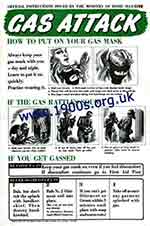Preparations for the threat of poison gas in WW2
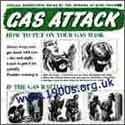
The threat of German mustard gas attacks was very real in the UK in WW2. This page describes what the gas was, why it was so feared and the various ways that the Government prepared civilians for coping with it, should it come.
____
By the webmaster, a child in WW2, with additional research and firsthand contributions
Why the threat
As the Germans had used gas warfare in World War One, it was feared that they would also drop poison gas from aircraft on British civilians in World War Two. So every precaution against a gas attack was taken. The cost of it all astounds me, but there was little alternative if the public were to be kept safe.
What the poison gas was
The poison gas was called 'mustard gas' which got its name from its mustard-like smell, although various original posters show that the smell was also likened to garlic, horseradish sauce and even geraniums.
Mustard gas was actually a liquid at room temperature but it vapourised easily, causing blisters and severe irritation on contact with the skin, eyes, nose and lungs. The pain and damage were longlasting and life-changing if not lethal. In the event, the gas was never used in WW2, but as child in the 1940s, I often heard personal recollections of WW1 veterans still suffering from it.
Consequently it was feared and dreaded as a serious threat in WW2, even though there had been a 1925 international treaty prohibiting its development and use in warfare.
Possibly the reason that gas attacks never came in WW2 was that Hitler realised how well prepared we were:
Gas detectors and advance warnings of gas attacks
contributed by Peter Johnson, personal recollections
Gas detectors to alert the public to a gas attacks were located outside observation posts, which were underground bunkers dug very deep into the ground, probably over twelve feet or so deep, and manned by the ARP and the Home Guard who reported on the numbers and direction of enemy planes overhead.
These gas detectors were large square boards painted yellowish green on top of poles. To me they looked something like large bird tables. Gas sensitive paint on the boards would change to red in the presence of mustard gas.
Gas detection paint was also applied to the tops of Post Office pillar boxes.
In Edmonton where I lived, one of the observation posts was in Pymmes Park and another at the Cambridge Roundabout.
contributed by John Benson, childhood recollection
As a child, I remember dustbin lids painted with gas detection paint fixed to the walls of the houses in our neighbourhood. I was told that they would change colour in the event of a gas attack and that if this happened, I should immediately put on my gas mask.
If the Germans had dropped gas, I suspect that the effects would have had a fairly short range, as the noise of the wooden 'clackers' designed to warn of a gas attack must themselves have had a fairly short range.
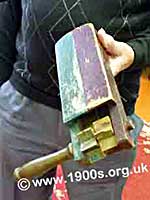
Rattle or clacker alert, held by handle and whirled round to alert for poison gas**.
Publicity to prepare for gas attacks
There was a great deal of publicity about how to recognise and cope in a gas attack. For example: Even before the war started in 1939, a leaflet on how to store and use gas masks was distributed to the public. There were also warning posters publicising the danger.
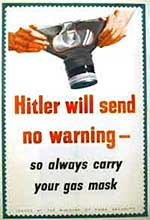
Poster warning everyone to carry their gas mask*.
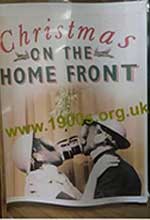
Poster of kissing through gas masks reminds me of touching elbows in the pandemic.
Cigarette cards, which have their own page and came in sets dedicated to different interests, had a set was what to do in an air raid and gas attack. It was excellent at reaching the wider public because smoking was so widespread, and collecting cigarette cards was a common hobby for children. It was a rare household where no-one smoked and at the time every packet contained a cigarette card. The fact that a buyer had no idea what card was inside any packet led to considerable bartering - and hence gas attack publicity.
Gas masks ordered well in advance by Neville Chamberlain
Neville Chamberlain, the Prime Minister in 1937 has widely been accused as an appeaser, i.e. going along with Hitler's demands rather than fighting. This is untrue and unfair - see the following box.
contributed by Tim Topps
edited extract from The Daily Telegraph 21 November 2019
10 million gas masks were ordered by Neville Chamberlain as early as 1937. He knew then that war was coming, played for time as we were not yet ready, and we owe him an apology for regarding him as an appeaser.
Gas masks for adults and for children and babies have their own pages.
*Photographed by the webmaster in the Museum of Nottingham Life
**Photographed by the webmaster in Lincolnsfields Childrens Centre
| sources | webmaster | contact |
Text and images are copyright
If you can add anything to this page or provide a photo, please contact me.


